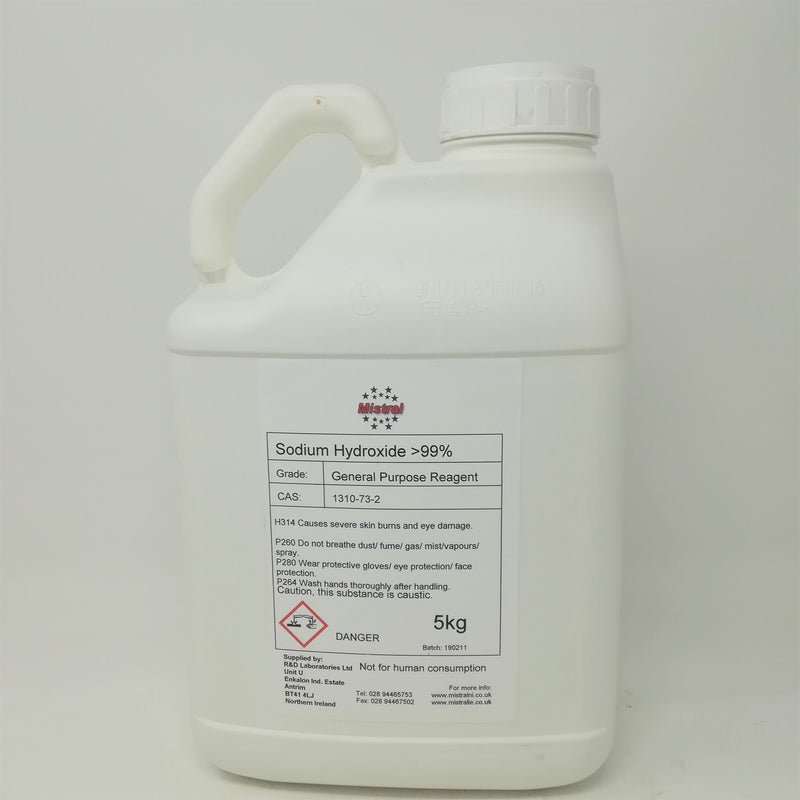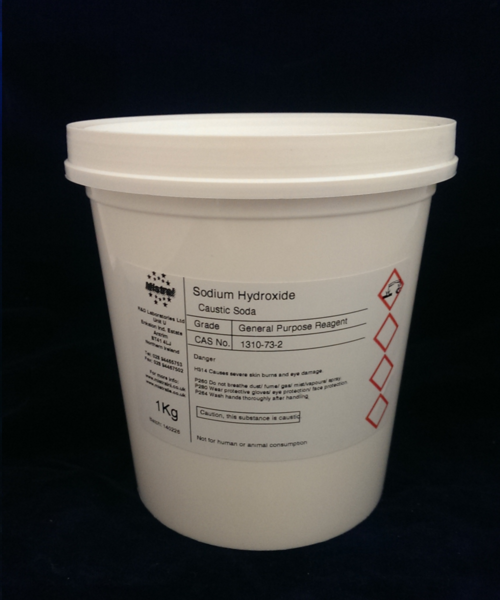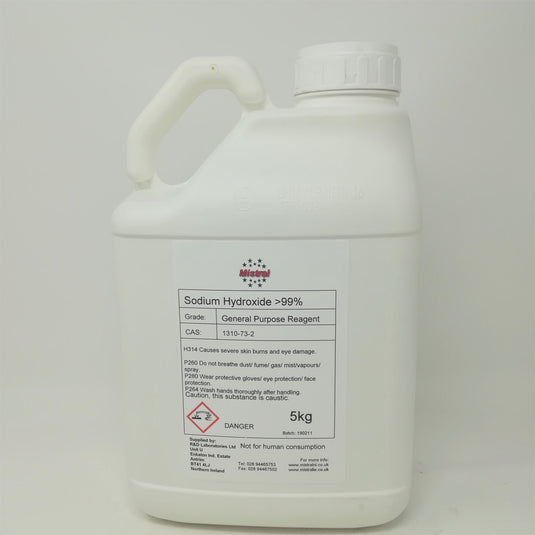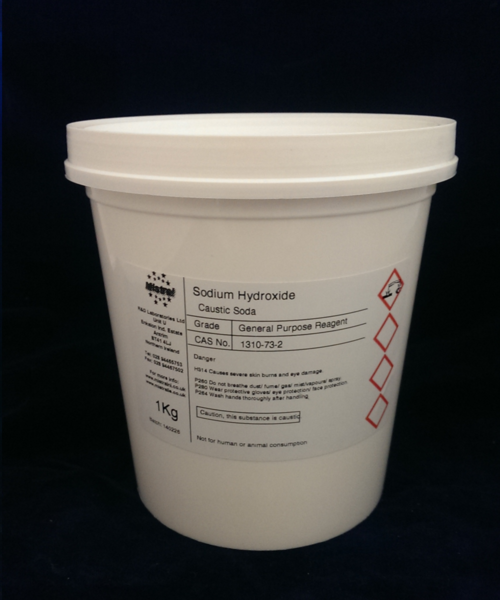

SODIUM HYDROXIDE
Caustic Soda Pearls/Prills
Technical grade
Sodium hydroxide (NaOH) commonly known as caustic soda, is supplied as white micro-pearl granules. It is deliquescent and rapidly dissolves in water and forms concentrated solutions of sodium hydroxide also known as caustic liquor or lye. Concentrated solutions in water are clear in colour. NaOH is a strong alkaline substance that dissociates completely in water to sodium and hydroxyl ions. It quickly absorbs carbon dioxide and water from the air. When near moisture, sodium hydroxide can burn or eat away at animal and vegetable tissue and some metal (corrosive). Sodium hydroxide mixes easily with water, alcohol and glycerol. It generates heat while dissolving being an exothermic reaction.
Sodium hydroxide is used to manufacture soaps, biodiesel, rayon, paper, dyestuffs, and petroleum products. It is also used in processing cotton fabric, laundering and bleaching, metal cleaning and processing, oxide coating, electroplating, and electrolytic extracting. It is commonly present in commercial drain and oven cleaners. It is a common laboratory reagent for pH adjustments, titrations etc
Sodium Hydroxide is manufactured by the electrolysis of salt (sodium chloride). Solid sodium hydroxide is obtained from this solution by the evaporation of water.
Sodium hydroxide is highly corrosive and should only be handled by professionals and suitably trained persons. It is not for sale to the general public.
PLEASE NOTE: This product is not for human or animal consumption.
Properties of Sodium Hydroxide
- Synonyms: caustic soda; lye; sodium hydroxide solid; sodium hydrate;
- CAS No: 1310-73-2
- EINECS No: 215-185-5
- Molecular formula: NaOH
- Molar mass: 39.99 g/mol
- Density: 2.13g/cm3
- Solubility in water: 111 g/100ml (20C)
- Melting point: 318 C
- Boiling point: 1388 C
- pH: 13 - 14
- Vapour pressure: < 24,00 hPa at 20 C
- Vapour density: 1.38 (Air = 1.0)
NaOH solidifies at 20 C if the concentration is higher than 52 % (by weight), which can be considered the maximum water solubility at 20 C. The dissolution/dissociation in water is strongly exothermic, so a vigorous reaction occurs when NaOH is added to water.
It also dissolves in ethanol and methanol, though it exhibits lower solubility in these solvents than does potassium hydroxide. It is insoluble in ether and other non-polar solvents
Uses for Sodium Hydroxide
Sodium hydroxide is used for many applications including:
- In the manufacture of soap. It is used to saponify oils and fats, converting them to the sodium salt of the fatty acid (soap).
- A laboratory reagent. Sodium hydroxide is predominantly ionic, containing sodium cations and hydroxide anions. The hydroxide anion makes sodium hydroxide a strong base (alkali) which reacts with acids to form water and the corresponding salts.
- Cleaning products like Heavy duty degreasers, oven cleaners, parts washers, drain cleaners, Cleaners for milk parlour pipework.
- As a relaxer to straighten hair (For professional use only !!).
- Used to kill tree stumps and roots (see below)
- Metal polishes
- Paint & varnish stripping
- Aquarium products
- For Biodiesel Production (addition to methanol to form sodium methoxide)
- Water treatment
- Paper and pulp industries because the substance helps separate cellulose fibers from lignin. The freed cellulose fibres can then be formed into paper.
- NaOH is also used by the drink and beer industry to clean non-disposable bottles.
- It is used to revitalise acids in petroleum refining.
- Manufacture of polymers, rayon, cellophane etc
- It can be used as an additive in drilling mud to increase alkalinity in bentonite mud systems increases the mud viscosity.
- to mercerize cotton in the textile industry.
In the laboratory Sodium hydroxide has been used extensively to remove proteins from ion exchange, hydrophobic interaction, and gel filtration media. Sodium hydroxide is widely accepted for cleaning, sanitising, and storing chromatography media and systems.
Sodium hydroxide is frequently used as an industrial cleaning agent where it is often called "caustic". It is added to water, heated, and then used to clean the process equipment, storage tanks, etc. It can dissolve grease, oils, fats and protein based deposits. The sodium hydroxide solution can also be added surfactants to stabilize dissolved substances to prevent re-deposition. A sodium hydroxide soak solution is used as a powerful degreaser on stainless and glass bake ware. It is also a common ingredient in oven cleaners.
For clearing blocked drains, the powder is used directly by slowly pouring into the drain opening, followed by adding hot water extremely slowly and carefully.
For advice on specific uses of sodium hydroxide please email us with your questions.
***HOW TO CAUSTIC SODA TO REMOVE PAINT FROM WALLS:**
For every 10 litres of water you will need 4 cups of caustic soda (about 1 kilo) and 2 cups of flour/corn starch (0.5kg).
Make up 5 litres of each ingredient and then add the two together to make the 10 litres.
Apply at a rate of 1 litre of solution per 5 square metres of wall. you may need to repeat the process if first application does not remove all paint.
You will have to work out the square meterage of the wall and work out the amount of caustic needed ( bear in mind 1 kilo will treat about 50 square metres).
Using Caustic soda to dissolve and remove Tree Stumps:
Caustic soda can be used to kill tree stumps but the process can take several weeks or months. It prevents new shoots and roots being produced by poisoning the stump and eventually causing its demise.
The most common method of application involves drilling holes in the stump and pouring the crystals into the holes. Water is then carefully added into the holes to activate the caustic. Repeat applications will be required.
An alternative method is to apply a strong solution (1 part sodium hydroxide to 2 parts of water) to the surface of the tree stump. Repeat applications will be required.
Health & Safety
R-phrase(s): R35 Causes severe burns.
S-phrase(s): S26 In case of contact with eyes, rinse immediately with plenty of water and seek medical advice. S37/39 Wear suitable gloves and eye/face protection. S45 In case of accident or if you feel unwell, seek medical advice immediately (show the label where possible).
Click here to view Product Specification

